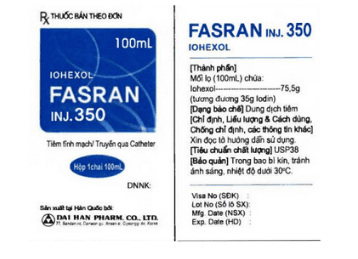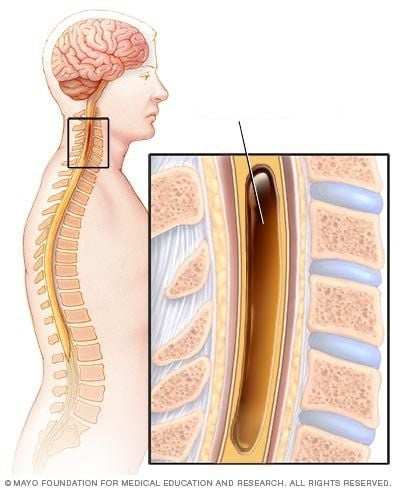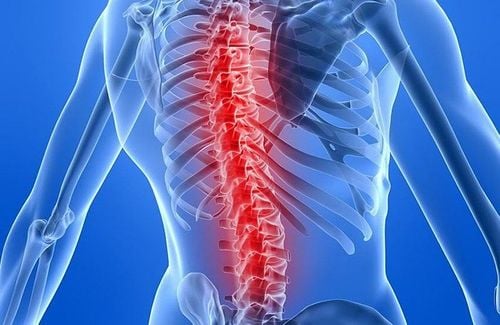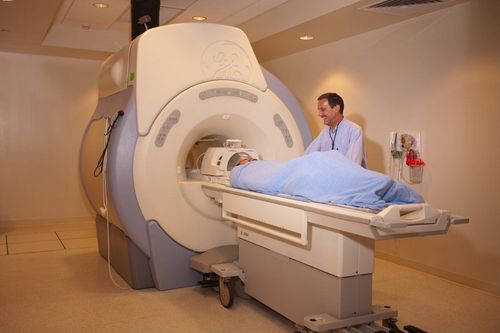This is an automatically translated article.
The article was written by Dr. Trinh Van Dong - Radiologist - Department of Radiology - Vinmec Ha Long International General Hospital.Magnetic resonance imaging machine 1.5 tesla or MRI machine 1.5 tesla is the generation of magnetic resonance imaging machine most commonly used in basic imaging investigations. The 1.5 tesla MRI scanner has many outstanding advantages over previous machines, so it is used in the diagnosis of diseases in many different organ systems in the body.
1. Magnetic resonance imaging for what?
Magnetic resonance imaging (English name is magnetic resonance imaging, MRI) is an imaging technique used in medicine. The mechanism of action is to use a magnetic field and a computer system to analyze the received electromagnetic waves to reconstruct images of the organs or tissue areas in the body that want to be examined. Magnetic resonance imaging is a non-invasive technique, providing high-contrast images, helping to examine organs, tissues and bones in the body in detail.
Most magnetic resonance imaging machines are large in size and weight with their giant tubular magnets. When the patient is put inside the machine, the magnetic field emitted from the machine is capable of gathering water molecules in the body. Radio-electromagnetic waves cause these molecules to gather to produce cross-sectional signals, which are processed electronically and produced in multiple MRI scans. This mechanism is often likened to the image of slicing a loaf of bread. Magnetic resonance imaging machines can also capture 3D images from a variety of angles.
Because the magnetic resonance imaging machine uses the high energy of the magnetic field, the presence of metal inside the patient's body is a risk because it can be sucked into the machine or interfere with the MRI image. Therefore, before performing the scan, the patient is always asked to remove all personal items made of metal and ask for a medical history to rule out replacement materials that have been implanted in the body before.
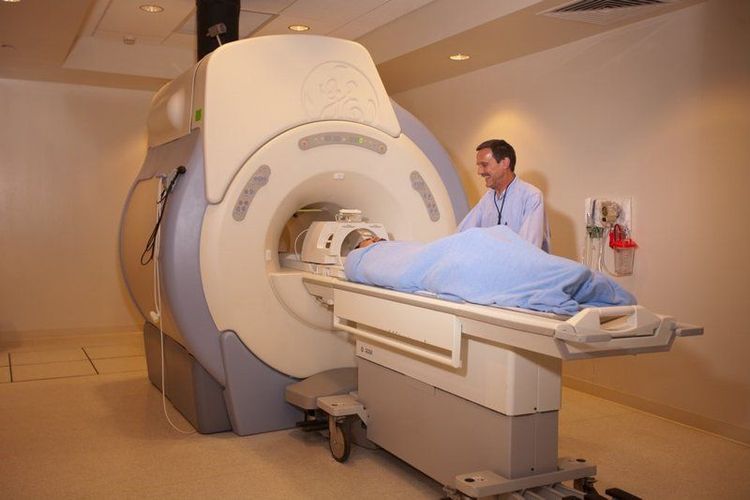
Chụp MRI cho phép chẩn đoán hình ảnh chính xác
2. Information about 1.5 Tesla . Magnetic Resonance Scanner
Magnetic resonance imaging machine to operate requires a sufficiently strong and stable magnetic field. The unit to measure the strength of a magnetic field is tesla (T). The limit of the magnetic resonance machines is usually from 0.2 to 7 Tesla, the most common are the 1.5 Tesla magnetic resonance machines or the 1.5 tesla MRI machines. Previously, when the new magnetic resonance machine was born, the magnetic field strength was achieved only at low levels. The first machine used in medicine was the 0.2 Tesla magnetic resonance machine. Thanks to the advancements and continuous development of technology, one by one more modern machines are upgraded and released
The magnetic field generated by the earth has a strength of 0.5 gauss (a unit of measurement of magnetic strength). school). The 1.5 Tesla magnetic resonance machine is capable of creating a magnetic field with a strength of about 15,000 gauss, 30000 times stronger than the earth's natural magnetic field. The magnetic resonance machine uses this region of the high-energy magnetic field to focus water molecules, and reconstruct the image. The intensity of the magnetic field generated by the magnetic resonance machine affects the quality of the received image signal. The introduction of the 1.5 Tesla magnetic resonance machine is considered a memorable milestone for the imaging profession. Using a 1.5 Tesla magnetic resonance machine allows to investigate many details of anatomical structures that were previously inaccessible with other techniques or for noisy images.
The 1.5 Tesla Magnetic Resonator is the basic type for routine imaging. In some cases such as prostate magnetic resonance imaging or functional survey magnetic resonance imaging, the magnetic field strength needs to be raised to higher thresholds such as 3.0 Tesla. The 1.5 Tesla Magnetic Resonator requires a longer operating time to get a clear image, while the 3.0 Tesla Magnetic Resonator requires less time but produces more detailed and sharper results.
3. What is the 1.5 Tesla MRI machine used in?
Indications for the use of 1.5 tesla magnetic resonance imaging or 1.5 tesla MRI scanners are now being expanded. The main role of the 1.5 tesla MRI machine is to support other imaging facilities for diagnosis and treatment monitoring with more accurate results. Application cases of 1.5 tesla magnetic resonance imaging machine include:
Surveying images of organs in the body to make an accurate and earlier diagnosis: magnetic resonance imaging machine capable of reconstructing images Anatomical images of organs and tissues in high resolution. The obtained images are not only 2D images as usual, but some machines are also capable of 3D rendering, greatly assisting doctors in evaluating and detecting abnormalities. Magnetic resonance imaging of the central nervous system and brain to aid in the diagnosis of brain aneurysms, multiple sclerosis, internal orbital abnormalities, spinal cord disease, stroke, and traumatic brain injury , brain tumor ... Magnetic resonance imaging of the heart and blood vessels to evaluate the size of the heart chambers, the thickness and movement of the heart muscle, determine the area of damage in myocardial infarction, abnormal aortic structure such as aneurysms or dissection, blood vessel wall thrombosis, ... Magnetic resonance imaging detects tumors in other organs such as liver and biliary system, kidney, spleen, pancreas, ureter, ovary , Prostate. Mammography, combined with mammography to detect breast cancer, especially in those with dense breast tissue or in groups of people with high risk factors. MRI of the skeletal system evaluates bone and joint injuries after trauma, abnormalities in the spine, discs, osteomyelitis, or tumors of the bone and surrounding soft tissue. In recent years, the 1.5 tesla magnetic resonance imaging machine is also used in prenatal diagnosis, detecting birth defects for timely counseling and treatment measures. Diagnosis of prenatal abnormalities by MRI is often indicated when ultrasonography cannot be conclusive, especially abnormalities involving the central nervous system.

Chụp MRI giúp chẩn đoán ung thư vú
4. Outstanding advantages of 1.5 Tesla MRI machine
The 1.5 tesla magnetic resonance imaging machine has many outstanding advantages such as:
Non-invasive and highly safe. Magnetic resonance imaging with 1.5 tesla MRI machine is not exposed to X-rays. There are no contraindications for pregnant women and young children, expanding the scope of diagnosis and treatment. Provides high resolution images that evaluate the structure of organs and soft tissues in detail. Detects small-sized lesions, in difficult-to-identify locations. Shorten the imaging time compared to low tesla magnetic resonance machines. The noise when operating the 1.5 tesla MRI machine has been much reduced compared to the older generations, Contrast, if used when taking the 1.5 tesla MRI machine, is less likely to cause side effects such as anaphylaxis . Vinmec International General Hospital with a system of modern facilities, medical equipment and a team of experts and doctors with many years of experience in examination and treatment, patients can rest assured that they will be examined and treated with confidence. treatment at the Hospital.
Master, Doctor Trinh Van Dong has nearly 10 years of experience in the specialty of Diagnostic Imaging, especially has strengths in performing techniques: X-ray, ultrasound, computed tomography, magnetic resonance. Currently, Dr. Dong is working and working at the Department of Diagnostic Imaging, Vinmec Ha Long International General Hospital.
To register for examination and treatment at Vinmec International General Hospital, you can contact Vinmec Health System nationwide, or register online HERE.
MORE
When do you need a magnetic resonance imaging (MRI) scan? In what cases is an MRI scan of the lumbar spine indicated?-P1 What to prepare for a magnetic resonance imaging (MRI) scan with contrast injection





